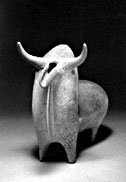|

Comment
on this story
What:
Wit and Wine: Ancient Iranian Ceramics
Where:
UT's McClung Museum, 1327 Circle Park Drive
When:
Through May 19; Mondays-Saturdays: 9 a.m. to 5 p.m.; Sundays: 1 to 5 p.m. Call 974-2144 for further info.
|
|

Wit and vessels for fruits of the vine come to Knoxville
by Heather Joyner
Entering a large, low-lit room, we notice it extends into near-darkness, spotlights illuminating more than forty jugs. Sounds like a strip club, right? Well, in an odd way, seeing the McClung Museum's new exhibit of ancient Iranian ceramics (titled Wit and Wine) is not entirely unlike going to th'Katch. Both places find us caught up in an abundance of voluptuous shapes and the universal quest for a good time. There's a sense of the exotic, the intoxicating, and the somewhat naughty. The mention of one venue might provoke extreme interest while the other inspires only mild curiosity—if not a gaping yawn. Of course it's up to each of us to determine which response is which.
Wit and Wine's curator, Dr. Trudy Kawami, breezes into the McClung's special exhibition space one afternoon in late February. Despite having just flown in from New York, she seems energized; her enthusiasm and quirky humor draw docents-in-training close as she describes the objects on display. As Director of Research for the Arthur M. Sackler Foundation, Kawami represents the esteemed and esoteric world of archaeology and art history scholarship. Well-educated and worldly, she could be intimidating. Instead, she is engaging as she moves from one piece to another saying things like, "With this vessel, you get an especially showy pour." The first such exhibit to travel the states in more than a decade, Wit and Wine is Kawami's baby, presenting ceramics from a 5,000-year period rivaling the artistry of Chinese, Greek, and pre-Columbian traditions.
The presumed ceremonial uses and cultural meaning of featured objects is Kawami's focus. In her book accompanying the show, she asserts that although archaeology is what brings us such finds, it's art history that revitalizes them by exploring the aesthetic aspirations they project. If we consider all that's happened in the past two thousand years and multiply that time by four, we're likely to feel removed from what we're looking at. But Kawami reminds us that Wit and Wine is not so much a show about time as it is about human beings. One need not know when the Neolithic Age began to appreciate finely-wrought ceramics that reveal a lust for life and love of sculptural form.
Although objects in the current show were by no means everyday items belonging to the average person living long ago in what is now Iran, they possess a down-to-earth charm. References—often humorous—to a range of beasts and to sexuality suggest a pre-Islamic frivolity that even Greeks perceived as excessive (i.e., they viewed elite Wit and Wine society types as indefatigable party animals—the ancient, Near East equivalent of rowdy Irishmen). There are vessels in the shape of a crocodile, a bird, rams, stags, and camels. And there are bulls galore. Pouring red wine, they perhaps alluded to sacrificial blood-letting. They no doubt symbolized fertility and regeneration.
Vera Bremseth, the McClung's Director of Marketing, favors a bull on wheels from 1,000-700 BCE. Resembling a pull-toy of sorts, it puts a twist on the notion of portable pleasure. A leg-shaped vessel from somewhere near modern-day Azerbaijan could be the German beer boot's first incarnation. As for sexy references, the unusual attention paid to male as well as female apparatus should delight female museum-goers of all ages. Also unexpected is the androgynous thrust (forgive me) of a figurine from Northern Iraq. Two horse-like vessels are labeled as having contained cosmetics used by both men and women.
Wit and Wine's non-figurative pieces are equally intriguing, albeit on a more abstract level. Often featuring spouts longer than their bodies, "pitchers" that poured wine in a dramatic arc may have been used to ritualize agreements or transactions between families. A dark ovoid jug dating to around 1,200 BCE is both simple and luscious. Its buxom-verging-on-pregnant shape atop a small base is reminiscent of figures sculpted by Gaston Lachaise: massive, yet balanced and graceful.
Kawami's enlarged color photographs of the Zagros Mountains, Caspian Sea, and other places occupy wall space alongside diagrams. Revealing the interior design of various vessels, the diagrams are informative and surprisingly interesting. For instance, one drawing shows a siphon-like tube running from the muzzle of a stag figure down its neck into the base. Other ingeniously crafted pieces are similarly illustrated. Ironically, nary a drop of wine was served at the Wit and Wine exhibit's opening reception (due to UT's "no alcohol policy," an all-encompassing policy purportedly shared by only one other southeastern school—the University of Mississippi). Alas.
I asked Kawami if we know for sure that most of the exhibit's pieces were used for wine. She explained that residue found in other containers provides a link, but that without written documentation we can only speculate. However, there is about these remarkable objects a kind of je ne sais quoi, an undeniable hint of celebration and indulgence. It's heady stuff.

February 28, 2002 * Vol. 12, No. 9
© 2002 Metro Pulse
|